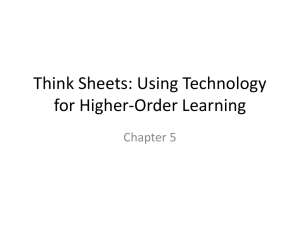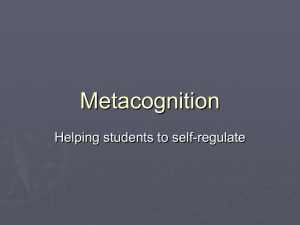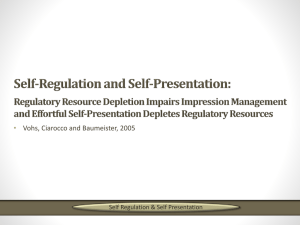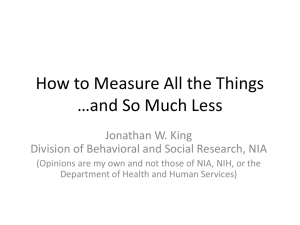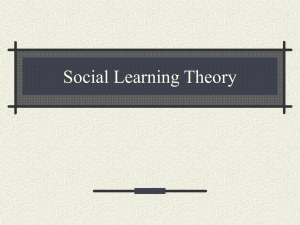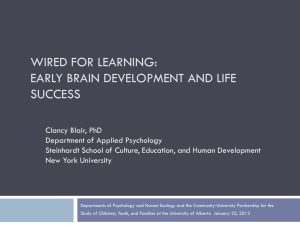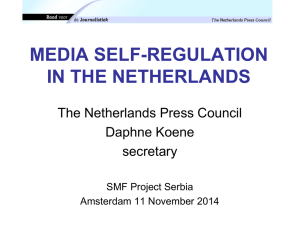Do More with Less: Self-Regulation Training in 3 Steps
advertisement
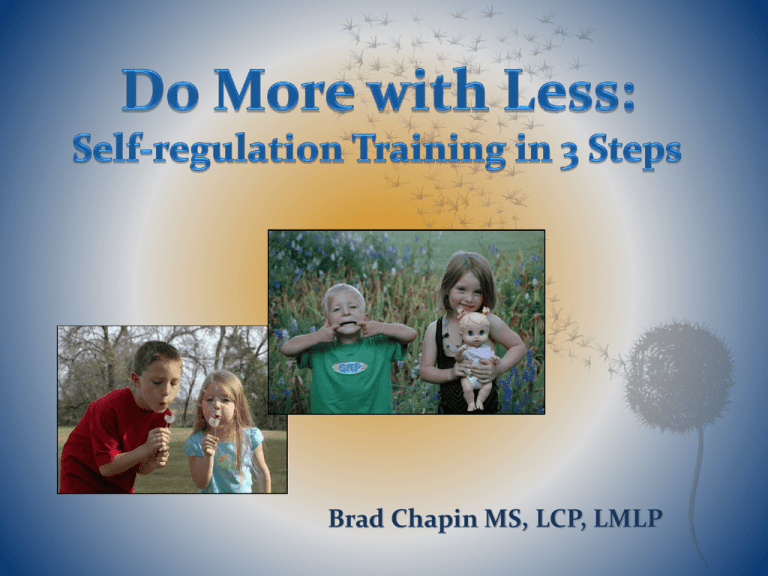
Brad Chapin MS, LCP, LMLP Why is He so Excited? Collaboration It’s all driving toward: Helping us get the most out of our efforts Helping all of the children in our community reach their full potential Overview The Need for a Framework Why Self-regulation = Success? Self-regulation Skill-training Framework Essentials Broad Flexible Fundamental Simple & Easy to implement Makes sense Solid empirical foundation Efficient Effective Goals of a Consistent Framework Consistency Continuity Common Language Improved Coordination of Services Gives a way to evaluate and introduce New tools Efficiency – Doing More with Less Helpful from Assessment through Intervention Improved Outcomes A Framework is a Guide for the Long-term School-wide like Positive Behavior Supports It’s easy to get side-tracked or revert to old habits Questions that lead to an Exceptional Framework: Based on your experience, what is the Golden Thread that leads to overall Success? Can we identify one set of skills that predicts success across many domains? If you had to choose one set of skills for your own children to learn, what would it be? The answers to All 3 questions include Self-regulation Beg for Applause here. If nothing but crickets chirping, KEEP MOVING! Self-Regulation… What’s He Talking About Anyway? Very, Very Broad Interpretation Self-control Self-efficacy Responsibility & Accountability Homeostasis Appropriate Responding Moderating Behavior Effortful control – Proactive vs. Reactive Working definitions of Self-regulation Learning to regulate one’s own Physical, Emotional, and Cognitive processes in healthy, pro-active ways to be successful across several domains of life Healthy, adaptive and “appropriate” responding to internal and external events Self-regulation is Directly related to Success in many areas including: Learning Academic Performance Social Interaction Overall Health Safety Developmental Issues In short…. Self-regulation = Success Poor Self-Regulation is also related, but in a negative way. A Moment on Safety & Self-regulation Poor Self-regulation leads an individual to feel like they have “no control” What do individuals who feel that they are being controlled tend to do? Those that regulate poorly are more likely to be victims of bullying (Macklem, 2003) Poor Self-regulation leads to Extremes Extreme thoughts Extreme behaviors Self-regulation & Academic Performance Duckworth, A.L., & Seligman, M.E.P. (2005). Self-discipline outdoes IQ in predicting academic performance of adolescents. Psychological Science, 16(12), 939-944. NEWS FLASH! Self-regulation isn’t just for children with special needs Self-regulation isn’t just for children Self-regulation and Life Expectancy Dr. Grossarth-Maticek's Longitudinal Experiment http://www.attitudefactor.com/srexper.htm What is the Goal? Self-Regulation Age External Regulation Age Integrating Our Efforts to Promote Self-regulation: A Common Message The Opportunities for sharing a common framework are all around us Mental health in schools RTI and MTSS Effective Classroom Management Positive Behavior Supports Cross-training Partnerships between organizations Health Care Reform Drawing Parallels & finding the Golden Thread: What Can Work at All Levels? Level of Care Model At Risk Prevention & Management Self-regulation Training Framework Cognitive-behavioral Psychology Provides Evidence Base Self-Regulation Strategies Physical, Emotional, Cognitive Regulation Skill Domains Academic Performance Aggression/Violence Anger Anxiety Attention Attribution Cognitive Flexibility Depression Emotional Control Executive Function Impulse Control Learned Helplessness Locus of Control Longevity Happiness Oppositional Defiance Motivation School Safety Self-efficacy Self-esteem Social Interaction Success Trauma Well-being © 2010 Chapin Psychological Services, LLC Assumptions of the Self-regulation Framework Children will do well if they can (Green & Ablon, 2006). Assumptions of the Self-regulation Framework One must be physically calm to effectively engage in problem-solving and learning (Goleman, 1998, Macklem, 2008 ,Yerkes & Dodson, 1908). Human beings have little control over their environment, but a great deal of control over their responses to their environment (Ellis, 1962). The relationship is likely the most important variable when trying to help someone change (Hubble, Duncan & Miller, 1999). Assumptions of the Self-regulation Framework Cognitive-behavioral psychology works (Beck & Fernandez, 1998; Butler, Chapman, Forman & Beck, 2006). Effective Self-regulation is critical for success and happiness (Baumeister, Heatherton, & Tice, 1994; Duckworth & Seligman, 2005; Masten & Coatsworth, 1998). In order to be effective, we need to meet children where they are currently functioning (Greene, 2006; Bailey, 2001). Do not assume that children have learned anything about how to regulate their own behaviors in a healthy way. Selling Self-regulation: The Challenge of Engagement Who wants to live longer? Who wants to be happier? Who wants to make more money and be more successful? What does that mean to you? Who wants to have more friends? Who’s tired of being told what to do all of the time? Who wants to be successful? Three Functional Categories of Self-regulation Skill Training Physical Emotional Cognitive What is Physical Regulation? When the Physical response is triggered (Fight/Flight/Freeze): Lower Brain is in command Higher thinking not engaged Body is ready for action Performance requiring thought is compromised Learning is decreased Problem-solving is decreased Yelling, screaming, pushing, hitting, kicking, biting, throwing things, spitting, “shutting down”, etc. People can get hurt http://www.youtube.com/watch?v=trPuXkbTpok Physical Regulation Skill-training Goals of Physical Strategies: Moderate the Fight/Flight/Shut-down ; Autonomic system Move back “up” from the brain-stem Return body to baseline Promote a Feeling a Safety and Security Physical Strategies include: Repetitive movements Stretching Change of physical position Breathing Relaxation Distraction Biofeedback Can take advantage of Imagination and Visualization – Suggestion, Association My Warning Signs One of the first steps in diffusing emotional upset is successful recognition of the physical changes that take place in the body. Common Warning signs Draw Yourself Here 1. Upset stomach 2. Headache 3. Clinched fists 4. Loud voice 5. Red face 6. Restless, fidgety, twitchy 7. Heart beating faster or louder 8. ___________________________ 9. ___________________________ 10. ___________________________ How I Calm down when these changes happen: ______________________________________________________________________________ ______________________________________________________________________________ ______________________________________________________________________________ © 2010 Chapin Psychological Services, LLC Children who do not regulate well have difficulty calming down physically when they are upset. © 2010 Chapin Psychological Services, LLC Melting Freeze Worksheet “Pretend your muscles are like water. Now we are going to change the form of our muscles to frozen (tense) like ice and then back to melted (relaxed) like water.” This strategy teaches children who are angry how to take control of their anger by utilizing visualization and deep breathing to harness their emotion and pro-actively “cool” it down. In this activity the child will both Give and Receive visual images that signal the body to calm down. © 2010 Chapin Psychological Services, LLC Cooling the Flame Worksheet – Version 1 Physical Regulation Skill-Training Do: Remove Stimulation Practice and Prevention Reduce Stress Give Space Calming Exercises Rhythmic Repetitive Movements and Stretching Do Not: Try to teach Argue Lecture Try to Win Prove a point What is Emotional Regulation? Goals of Emotional Strategies: Accurately identify emotions; our own and those of others Own and accept responsibility for our feelings Express feelings in healthy, appropriate ways Emotional Strategies Include: Identification and Labeling Expression training Responsibility for feelings You Can’t Make Me Laugh Children struggling with selfregulation often do not understand the power they have over their own emotions. Take turns using funny words, stories, faces or actions to try to get each other to laugh. Time limit: Each person gets 30 seconds to get the other to laugh. Rules: 1. No touching or invading personal space during this game 2. Keep words and actions appropriate 3. Have fun! Strategies used: 1. _____________________________________________________ 2. _____________________________________________________ 3. _____________________________________________________ © 2010 Chapin Psychological Services, LLC Free Emotional Expression Free Healthy Expression Worksheet Children who struggle with self-regulation often have difficulty expressing the feelings they have in healthy ways What are some things you are interested in? 1. 2. 3. 4. _______________________________ _______________________________ _______________________________ _______________________________ Healthy ways I can Express my: Anger 1. Talk with someone about it 2. __________________________________________ 3. __________________________________________ Sadness 1. Talk with someone about it 2. __________________________________________ 3. __________________________________________ Fear/Worry 1. Talk with someone about it 2. __________________________________________ 3. __________________________________________ Happiness 1. Share it with someone 2. __________________________________________ __________________________________________ © 2010 Chapin Psychological Services, LLC What is Cognitive Regulation? Goals of Cognitive regulation: Problem-solving skills Incorporate Psychological Needs/Motives Engaging higher cortical areas of the brain Planning and organization skills Insight and Understanding Forming healthy beliefs about ourselves and the world around us Cognitive Strategies include: Specific training to problem areas Insight-oriented teaching to promote understanding Learning about his/her own patterns of behavior Children struggling with selfregulation often have difficulty complying with rules and limits. A critical part of self-regulation is understanding that one’s own actions can dictate the amount of freedom they are granted by parents, teachers and others in authority. Defiance Trap Worksheet First, draw yourself in the trap below. Next, list the Freedoms or Privileges you would like to earn: 1. _____________________________________________________________________ 2. _____________________________________________________________________ 3. _____________________________________________________________________ Write in thoughts or rule-breaking behaviors that are keeping you from reaching your goals: 1. ______________________________________________________________________ ______________________________________________________________________ 2. ______________________________________________________________________ ______________________________________________________________________ 3. ______________________________________________________________________ ______________________________________________________________________ © 2010 Chapin Psychological Services, LLC Domino Effect Worksheet Those who struggle with selfregulation often have difficulty understanding the fact that they can control their own emotional and behavioral outcomes for events that take place in their lives Let’s look at how you can control the outcome. Activating Event Decision points (interventions) 1. 2. 3. 4. Positive Pro-active Ending End Result (Negative) Jimmy 8 years old ADHD Diagnosis Developmental delays Assessment Behaviors To Address 1st Rating (1-10) Strategy Used Response Outcome Rating (1-10) Recognizes physical signs Does not recognize signs 1 My Warning Signs Name warning signs and triggers 75% of the time 7 Uses healthy calming strategies successfully Has no calming skills. Wants to sleep after outbursts 1 Cooling the Flame Uses skills 80% of the time 8 Physical My Safe Place Cognitive Deficits Behaviors at school and at home Anger Outbursts Poor Social Skills Emotional Identifies feelings Recognizes responsibility and ability to change Expresses Emotions in healthy ways Cognitive Replaces Unhealthy thoughts with healthy beliefs Uses Cognitive strategies to problem-solve Reports all emotions as anger or frustration 2 Feelings Clip Art Names feelings accurately 90% of the time 9 Blames others for his emotional responses 1 You Can’t Make me Laugh Understands his emotions are his to control 10 Draws his feelings out on paper 8 Hits, Yells, Pushes, Throws things 1 Struggles with consistent beliefs about himself and others 1 No healthy cognitive strategies 1 Strengths: Can be helpful, likes computers Challenge Software Free Emotional Expression Barriers: Developmental delays, family involvement Challenge Can you think of any situations you have struggled with that don’t involve Self-Regulation in some way? Getting a Good Start Evaluate and Organize your favorite interventions/activities into: Physical Emotional Cognitive Speak the Language During Assessment During Discussion of Problem Areas During Intervention Selection During Implementation Contact Brad for Helping Implementing the Self-regulation Training Framework in Your Area Brad.chapin@cpschallenge.com Collaborative Information Psych Challenge Blog http://psychchallenge.blogspot.com Email Brad.chapin@cpschallenge.com Facebook – search Challenge Software Twitter id = chapin55 Book – “Helping Young People Learn Self-regulation” By Brad Chapin LCP, LMLP & Matthew Penner, LMSW Will be available at www.youthlight.com in December, 2011 www.cpschallenge.com brad.chapin@cpschallenge.com
